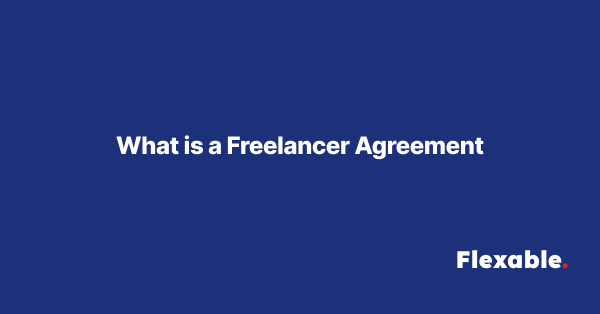A freelancer agreement is a legally binding document that outlines the terms and conditions of the working relationship between a freelancer and their client. It is a crucial tool that ensures transparency, sets clear expectations, and protects both parties from potential disputes. Whether you are a seasoned freelancer or a client hiring independent contractors, understanding the importance and components of a freelancer agreement can pave the way for a smooth, professional collaboration.

Why Is a Freelancer Agreement Necessary?
In the freelancing world, where work dynamics differ from traditional employment, agreements serve as a vital anchor. Here’s why:
Clear Scope of Work:
A well-drafted agreement defines the tasks, deliverables, and timelines expected from the freelancer. This prevents misunderstandings and helps both parties stay aligned.
Legal Protection:
Freelancer agreements provide legal safeguards. In case of non-payment, scope creep, or missed deadlines, the agreement can serve as evidence in resolving disputes.
Professionalism:
Having an agreement signals professionalism. It sets the tone for a structured and organized working relationship, reinforcing trust between the freelancer and the client.
Financial Transparency:
Freelancers often face challenges related to inconsistent payments. A solid agreement includes payment terms that clarify rates, payment schedules, and invoicing methods, reducing financial uncertainties.
Intellectual Property Protection:
Ownership of work is a common concern in freelance projects. Agreements define intellectual property rights, ensuring clarity about who retains ownership of the final product or content.
Key Components of a Freelancer Agreement
While the content of a freelancer agreement may vary depending on the industry or nature of work, certain essential elements must be included:
1. Contact Information
Both parties should have their full legal names, business names (if applicable), and contact details clearly mentioned in the agreement. This ensures accountability and proper communication.
2. Scope of Work
A detailed description of the project, including specific tasks, milestones, and deadlines, should be included. For instance, a freelance graphic designer might outline the number of design drafts and revisions they’ll provide.
3. Payment Terms
Specify:
Rates: Whether it’s an hourly, per-project, or milestone-based payment.
Payment Schedule: When and how payments will be made (e.g., 50% upfront and 50% upon completion).
Late Payment Penalties: To ensure timely payments.
Currency and Method: Mention the currency and payment method (e.g., PayPal, bank transfer, etc.).
4. Revisions and Edits
For creative freelancers, it’s vital to outline how many revisions are included in the agreed rate. Additional revisions can be charged at an extra cost.
5. Ownership and Intellectual Property Rights
Clarify whether the freelancer retains ownership of the work or transfers it to the client upon payment. If it involves licensing, specify the terms of use.
6. Confidentiality Clause
If the project involves sensitive information, a confidentiality or non-disclosure clause can safeguard trade secrets and proprietary data.
7. Termination Clause
This outlines the circumstances under which either party can terminate the agreement, as well as any notice period required.
8. Force Majeure
To address unforeseen circumstances like natural disasters or emergencies that might impact project timelines, a force majeure clause can be included.
9. Indemnity and Liability
This clause limits the liability of the freelancer in case the client faces losses or damages due to the work delivered.
10. Dispute Resolution
Specify how disputes will be handled—whether through mediation, arbitration, or legal action—and the jurisdiction governing the agreement.
Tips for Drafting a Freelancer Agreement
Keep It Simple Yet Detailed:
Use clear and concise language. Avoid overly complex legal jargon unless absolutely necessary.
Tailor to the Project:
Customize each agreement to suit the specific project. Generic templates are a good starting point, but personalizing the details makes it more effective.
Seek Legal Advice:
If you’re unsure about certain clauses, consulting a lawyer can help you avoid potential pitfalls.
Ensure Mutual Agreement:
Before starting the project, both parties should review, agree to, and sign the document.
Common Misconceptions About Freelancer Agreements
“It’s Only Necessary for Big Projects”
Even small gigs can benefit from an agreement. It ensures clarity from the outset, regardless of the project size.
“Verbal Agreements Are Sufficient”
While verbal agreements may seem quick and convenient, they lack legal enforceability. Written agreements provide clear documentation.
“Templates Are Enough”
Generic templates are helpful but may not address industry-specific nuances or legal requirements in your jurisdiction.
Conclusion
A freelancer agreement is much more than a piece of paperwork, it’s the foundation of a successful and professional freelance relationship. By setting clear terms, ensuring legal protection, and promoting transparency, it benefits both freelancers and clients alike. Investing time in crafting a robust agreement at the start of a project can save you from misunderstandings, disputes, and complications down the line.
Whether you’re a freelancer looking to safeguard your business or a client aiming for smooth collaboration, a well-structured freelancer agreement is indispensable. It’s a step toward professional integrity and mutual respect, ensuring that both parties can focus on what they do best: delivering exceptional work.

